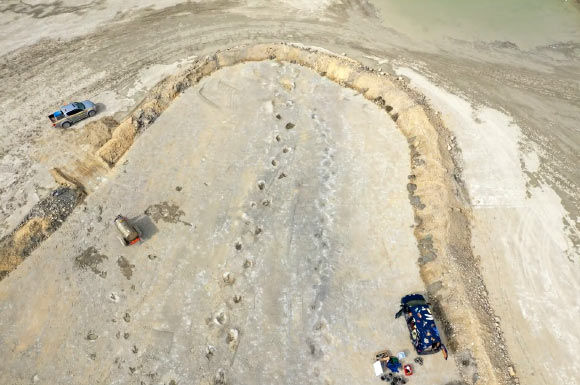In 2024, a major new sauropod dinosaur track site was uncovered at Dewars Farm Quarry, near Bicester in Oxfordshire, England. This year, paleontologists from the University of Oxford, the University of Birmingham, Liverpool John Moores University and the Oxford University Museum of Natural History uncovered around 200 more footprints making up four trackways, one of which is Europe’s longest sauropod dinosaur trackway.

The 166-million-year-old sauropod dinosaur trackways at Dewars Farm Quarry in Oxfordshire, England. Image credit: University of Birmingham.
The four new trackways found at at Dewars Farm Quarry date back to the Middle Jurassic period, some 166 million years ago.
They were left sauropod dinosaurs: large-bodied, long-necked herbivores like Cetiosaurus.
The finds include Europe’s longest sauropod dinosaur trackway, which spans approximately 220 m from the first to the last exposed footprint.
“We were delighted to be welcomed back to Dewars Farm quarry earlier this year, to continue excavating and discover more dinosaur tracks,” said University of Birmingham Professor Kirsty Edgar.
“This site in Oxfordshire is the largest dinosaur track site in the UK, and arguably now the largest mapped dinosaur track site in the world when we consider finds dating back to the 1990s on the same surface nearby.”
Over seven days, the team battled against a much drier, harder surface than the previous year focusing on a set of around 80 very large (up to 1 m long) sauropod prints, that ran approximately north-south across the entire site forming the record-breaking trackway.
In addition to the long sauropod trackway, three other shorter trackways were uncovered, one of which is a continuation of prints first found in 2022.
Although not continuously exposed, it may prove to be an even longer trackway once all the data is pieced together.
Smaller finds at the site included marine invertebrates, plant material and a crocodile jaw.
“Most of what we know about dinosaurs comes from their skeletons, but footprints and the sediments that they are in can provide valuable additional information about how these organisms lived and what their environment looked like over 166 million years ago,” said University of Birmingham Professor Richard Butler.
“Key new work in this latest excavation included systematic sampling of the sediments that both underlie and fill the footprints, with analysis of these currently underway to find out more about the environment in which they were made and how they were preserved.”
“More of the footprint surface is likely to be exposed over the coming years, and a full description of the significance, new scientific discoveries and potential for future preservation of the site is expected soon.”







